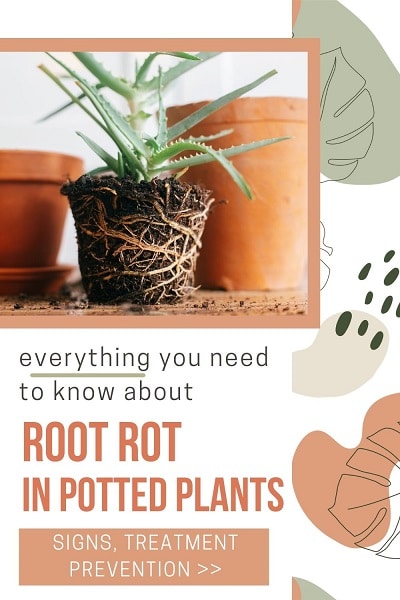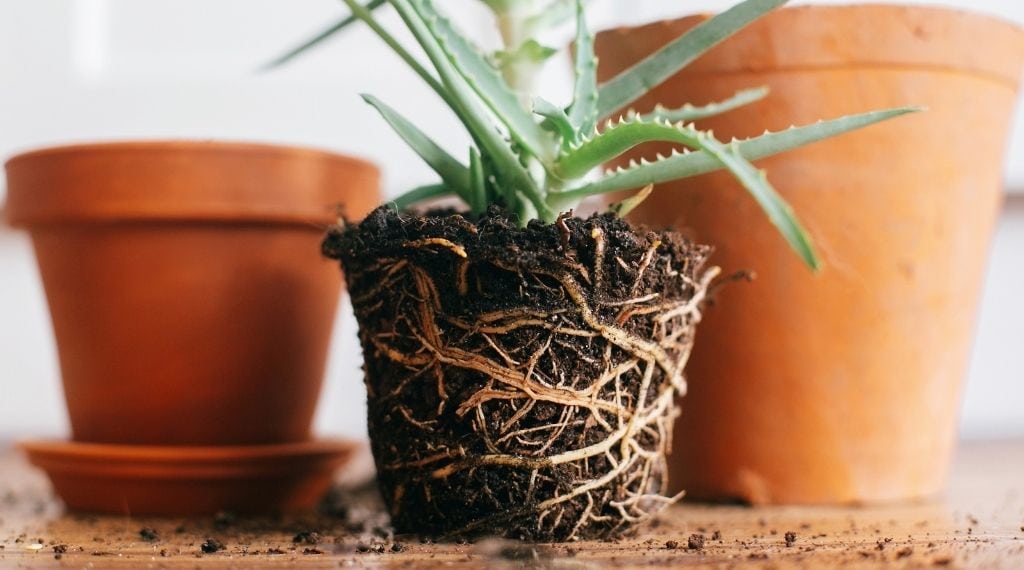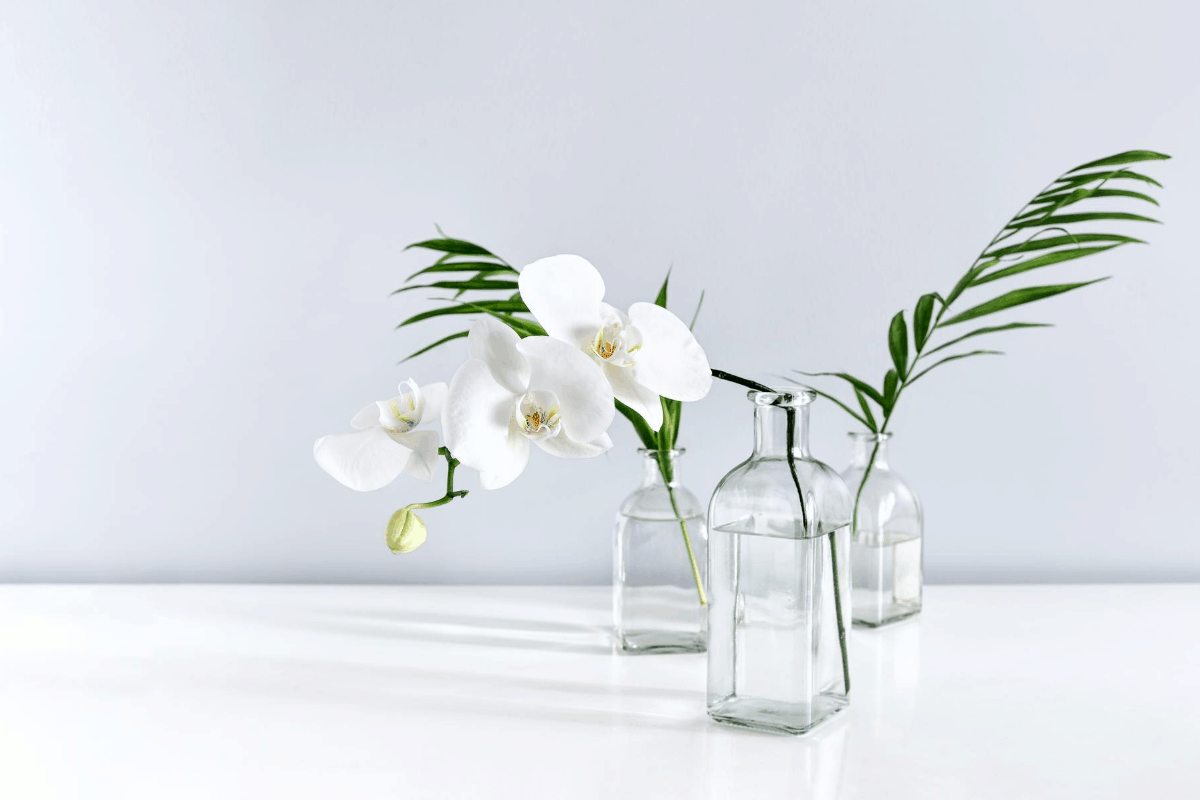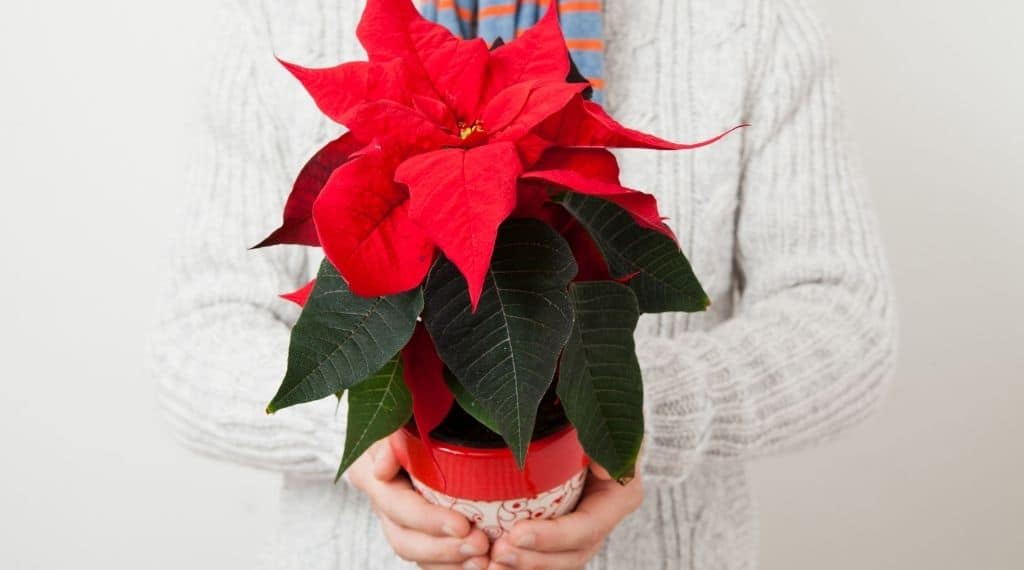Last Updated on October 13, 2021 by Plantiful Interiors
How To Prevent Root Rot In Potted Plants
Can you relate? You added a beautiful new potted plant to your home decor. When you brought it home from your local garden center it was vibrant, full and healthy looking.
You took very loving care of it and watered it regularly, but in the end, the plant died. This scene is very common actually.
One of the leading causes of death among plants is root rot. Plants are living beings that require specific care based on their hardiness.
This post contains affiliate links. As an affiliate partner of various brands, we earn a little commission on qualifying purchases, at no extra cost to you. When you purchase through our links, you help our business to keep going. So thank you for your support! You may read our full disclaimer for more information.
Many new plant parents struggle with nailing down a watering regime that works for both them and their plant. This often leads to either watering too often, or not often enough.
Or, if you’re like me when I first started owning plants; watering because you can’t remember if you already watered them that week.
Often times, if a plant is overwatered, it’s chances of recovery are slim – but not completely un-fixable, which we will get into later in this article.
If you want to know what are some signs your plant has root rot and how to prevent root rot in potted plants, you’re in the right spot!
Keep reading all the way to the end to learn how to be a great plant parent and avoid having your plants damaged by the dreaded root rot.
What is root rot?
Before diving into how to prevent root rot, it’s signs and prevention strategies, it’s important to understand what root rot actually is.
Root rot is a common disease in indoor plants that, as its name suggests, consists of the roots gradually rotting. This condition causes the plant to not be able to feed or absorb certain nutrients correctly, and this causes it to get sicker and sicker until it dies.
The main cause why the roots of a plant rot is due to lack of oxygen in the soil or substrate where the plant grows.
At the same time, this lack of oxygen becomes an ideal medium for certain types of fungi and bacteria to develop and begin to infect the plant, further contributing to root rot.
As root disease worsens, these roots will begin to decompose and the rot will spread to healthier roots, killing them as well, even if soil conditions are corrected.
It’s important to catch root rot quickly and treat it while there are still healthy roots to be salvaged.
When decomposition starts you’ll then see how your plant changes its appearance, losing its beauty and vitality until it finally dies.
The Importance Of Oxygen For Plants
As we described earlier, root rot starts due to a lack of oxygen in the soil. Many people already know that plants use the energy they get from the sun for photosynthesis to make their own “food.”
In this process, plants absorb carbon dioxide and release the oxygen that we breathe, but plants are also capable of doing the opposite: absorbing oxygen and releasing carbon dioxide, and in this process they also feed.
This respiration process is more intense during the night hours and to do it, plants capture oxygen through their leaves, although they can also do so through their roots.
The substrate in which plants grow serves them for several functions, but also as a place for the exchange of air between the roots and the atmosphere.
The key to a healthy and happy plant is that its roots fully develop, so it’s very important that the soil or substrate can drain excess water, so that stagnant air is renewed with new oxygen.
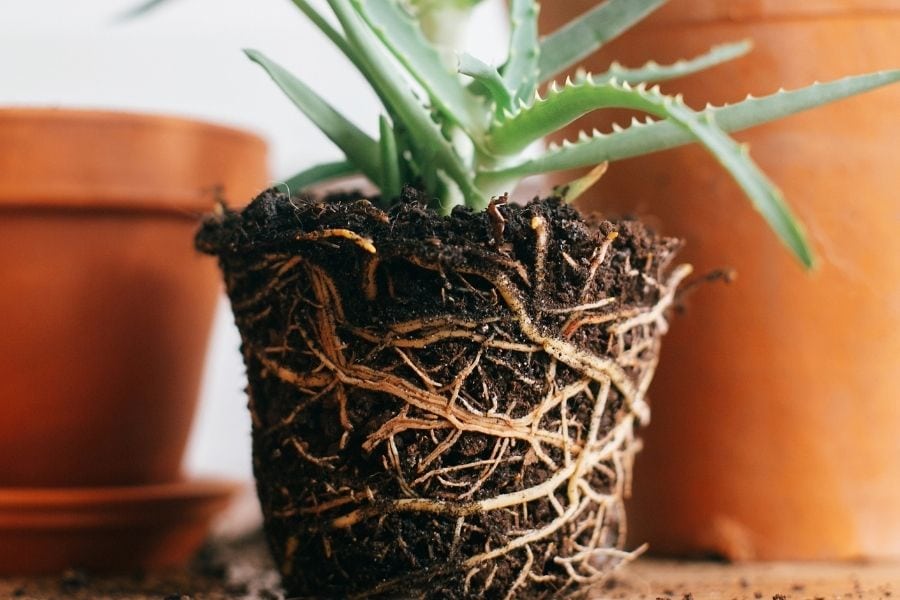
What causes root rot?
Now that you know what root rot is and the importance of oxygen to your plants, you need to know what impedes a plant to breathe freely.
Although it sounds strange, excess watering is usually the trigger problem of lack of oxygen in the substrate of the plants.
Based on that, for a plant to develop root rot, it must then go through several stages:
1. Excess water
Overwatering plants can cut off the air supply to plant roots, removing vital nutrients and creating the perfect environment for fungi and mold. Early signs of overwatering are soggy soil, a heavy pot, loose bark, and mold.
2. Insufficient drainage
If a pot doesn’t have enough drainage holes or they’re poorly distributed, or even if they’re not large enough, it’s most likely that the pot will accumulate an excessive amount of water inside.
Also, the type of substrate used can affect drainage, since some substrates are more compact than others, so they don’t allow too much air to pass through.
3. Insufficient oxygen
When the above two factors combine, they’ll inevitably lead to an insufficient supply of oxygen to the roots of the plant.
If the roots can’t absorb oxygen in a normal way, this implies that they can’t absorb other nutrients either, so they start to get sick.
4. Development of harmful fungi and pests
Under normal air and humidity conditions, fungi that are naturally present in the soil are kept at safe levels.
On the other hand, when there is an excess of humidity and this prevents a good flow of air between the pores of the soil, these fungi have the perfect conditions to proliferate, so they will invade the entire environment, including the roots of the plants.
At the same time, the appearance of these harmful fungi will help the proliferation of certain types of anaerobic bacteria that will further infect the roots of the plants.
Some of the most common types of organisms that contribute to root rot infection:
- Fusarium. It’s a fairly common soil fungus that is capable of feeding on the remains of dead plants – such as roots. Excess water and lack of air are an ideal medium for its development.
- Pythium. It’s an anaerobic bacterium that can also feed on decomposing plant matter. It develops and proliferates quite quickly.
- Fungus gnats. These are small insects that are attracted to humidity and the presence of fungi in the soil of indoor plants. They usually use organic matter to lay their eggs, and in this process they help spread fungal spores to other plants, with the consequent risk of infection. If you suspect you have fungus gnats – check out 5 Proven Techniques to Get Rid Of Fungus Gnats
Signs your plant has root rot
Determining if a houseplant is suffering from root rot can be difficult some times, as the disease develops underground. However, there are certain external signals that a trained eye can pick up with relative ease.
The following are the most common signs of root rot to watch out for; the problem is that when these signs appear, it’s most likely already too late to save the plant:
- Lower leaves turn yellow
- There is no normal growth on the plant
- The ground turns green
- Fungi are observed on the surface of the soil
Generally, if you notice that your plant is slowly wilting and the leaves are turning yellow for no apparent reason, it’s best to proceed to check the roots.
Remove the plant from the soil and check out the roots. Roots affected by root rot will appear dark brown early in infection, but in an advanced stage, they’ll be black and feel mushy, and may even literally fall off the plant when touched.
Note that the normal color of healthy roots may be black or pale white, but they’ll feel strong and flexible.
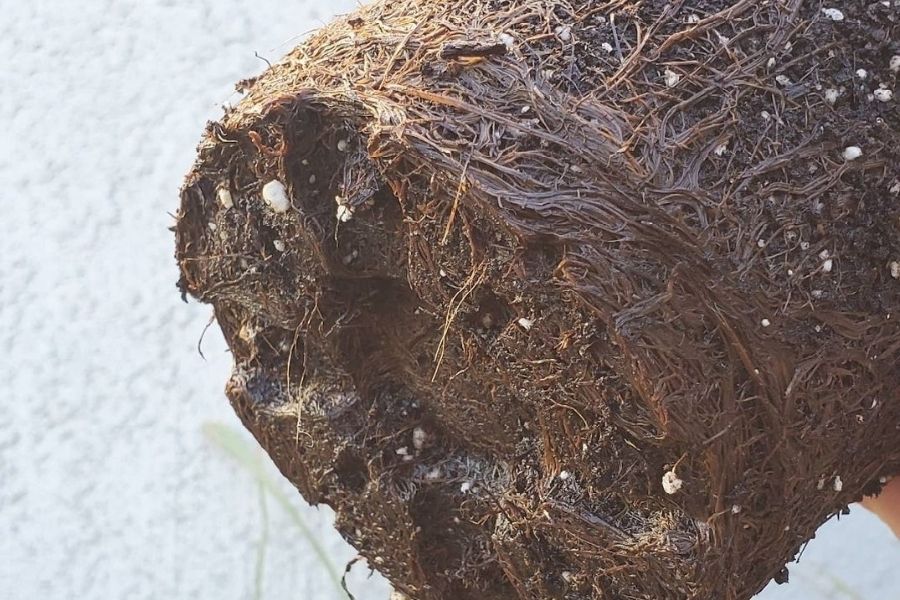
How to Treat Root Rot
Whether root rot is caused by a constant overwatering or a single excessive accumulation of water that caused a root fungus outbreak, you must act quickly. In this way, you’ll increase the chances for your plant to survive.
Begin treating the root rot by removing the plant from the soil and washing the roots with plenty of clean water. Wash and remove as much soil and affected roots as possible, but handle roots very carefully.
Then use a clean, sharp pair of pruning shears or scissors to cut off the rest of the affected roots. When treating root rot, you may have to remove a significant amount from the root system if the plant is severely affected.
If this is the case, you’ll need to clean the scissors with alcohol and proceed to prune 1/3 of the plant’s leaves. This will give the plant a better chance to regenerate the roots, as it won’t need to keep as many leaves, so it will use that energy for the roots.
Continue with the root treatment by discarding the soil from the pot the plant was in. Wash the pot well with a bleach solution.
Try dipping the remaining healthy roots in some type of fungicide to kill any possible root fungus. After you have done this treatment on the roots, you can proceed to replant in a clean potting mix.
A good option is to use mycorrhizae species or sulfur powder. These elements can create a rather unfavorable environment for the survival of fungi, so this will help to avoid reinfection.
Make sure the container has good drainage and avoid watering the plant too much until the top of the soil is “dry.” While the plant is regenerating its roots, don’t fertilize it, as this can stress it out.
Now you just have to give your plant some time to recover.
How To Prevent Root Rot In Potted Plants
The best strategy to have healthy and beautiful plants without root rot is prevention. Here are the best tips for this.
1. Maintain a well-drained soil
Try to avoid packed mud in plant pots. Imagine the substrate of the pot halfway between clay – that is capable of holding water – and completely porous sand.
You can improve this by adding perlite, vermiculite, bark or other coarse elements to give the soil porosity, preventing it from becoming too compact. Choose the best potting soil based on your plant’s needs.
2. Correct watering
Don’t water all the plants at once and to the same extent. Each type of plant has its specific irrigation needs; succulents will need less water than many tropical ones, for example.
If you allow the pot to saturate with water, allow it to drain completely. Also, remember to water less in very cool climates or in winter.
3. Choose the appropriate pot
The proper size of a pot for a particular plant will depend on the extent of its root system. It’s not good idea to have empty spaces in the pot where the roots can’t reach, since the water will stagnate and dead zones may develop that favor root rot. That’s why you must know the type of plant.
4. Give them space
Make sure your plants have good air flow around them. Your pots should have holes where the water can drain without difficulty, but these holes also serve to provide sufficient air exchange between the substrate and the outside environment.
5. Choose the right plants
Also note that some plants are more susceptible to root rot than others. Cacti and other succulents require less watering than other types of plants, making their roots prone to disease in excessively watery conditions.
Some of the plants most susceptible to developing root rot are:
- Mountain laurel
- Andromeda
- Yews
- Heather
- English lavender
6. Observe your plants
Constant observation is probably the easiest to use and also the most efficient tool to prevent root rot on your plants.
Observe your plants frequently so that you can take appropriate action early if problems arise. Watch for irregularities in plant growth or coloration, the rate at which the topsoil dries, and even signs of dormancy in the normal behavior of your plants.
Remember that all living beings, even plants, emit “signals” that humans can interpret. Learn more about your favorite plants.
Wrapping Up How To Prevent Root Rot In Potted Plants
Root rot is a very common disease that can kill indoor plants. The main cause is the inability of the roots to absorb oxygen and nutrients from the soil, which in turn is caused by overwatering and certain pathogens such as fungi.
In many cases, root rot can be treated if caught early, although the best strategy is to prevent plants from contracting the disease.
If you maintain good soil drainage and are constantly on the lookout for signs, your plants will most likely not contract the disease and will remain healthy and beautiful for a long time.
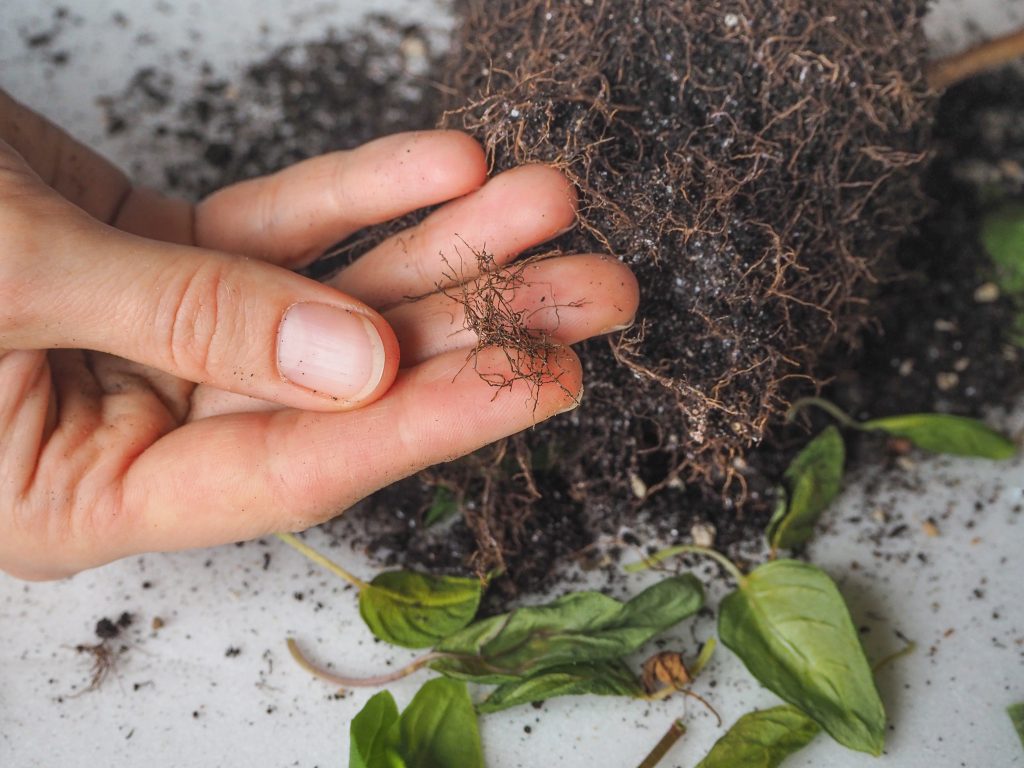
How To Prevent Root Rot In Potted Plants – FAQs
Can a plant recover from root rot?
Yes, of course. As long as you can detect the disease in the plant in time and take the necessary measures on the roots, you can save your plant.
Does hydrogen peroxide kill root rot?
Hydrogen peroxide is a compound that is found naturally in rainwater and that has fungicidal and pest repellent properties. If the root rot is caused by pathogens like fungi, peroxide will help, but this is less likely in cases where the roots of the plant simply “drowned” from too much water.
How fast does root rot happen?
Very fast. Even with just one day your plant is in a situation where its roots can’t breathe, root rot can happen. In the event that a plant has been invaded by fungi and bacteria, the root rot can kill the plant in a matter of about two weeks.
Is root rot contagious?
For other plants yes, but not for humans. There are certain insects that, by landing on infected plants, can transmit the infection to other plants with their legs. On the other hand, the pathogens that cause this disease in plants are very different from the pathogens that cause disease in humans.
Should I water after repotting a root rot plant?
It depends on the type of plant. Some plants such as cacti won’t require immediate watering after being replanted, since they have water deposits inside, while others will. As a general rule, it’s best to know your plant and not abuse watering.
Pin for later
How to prevent root rot in potted plants
